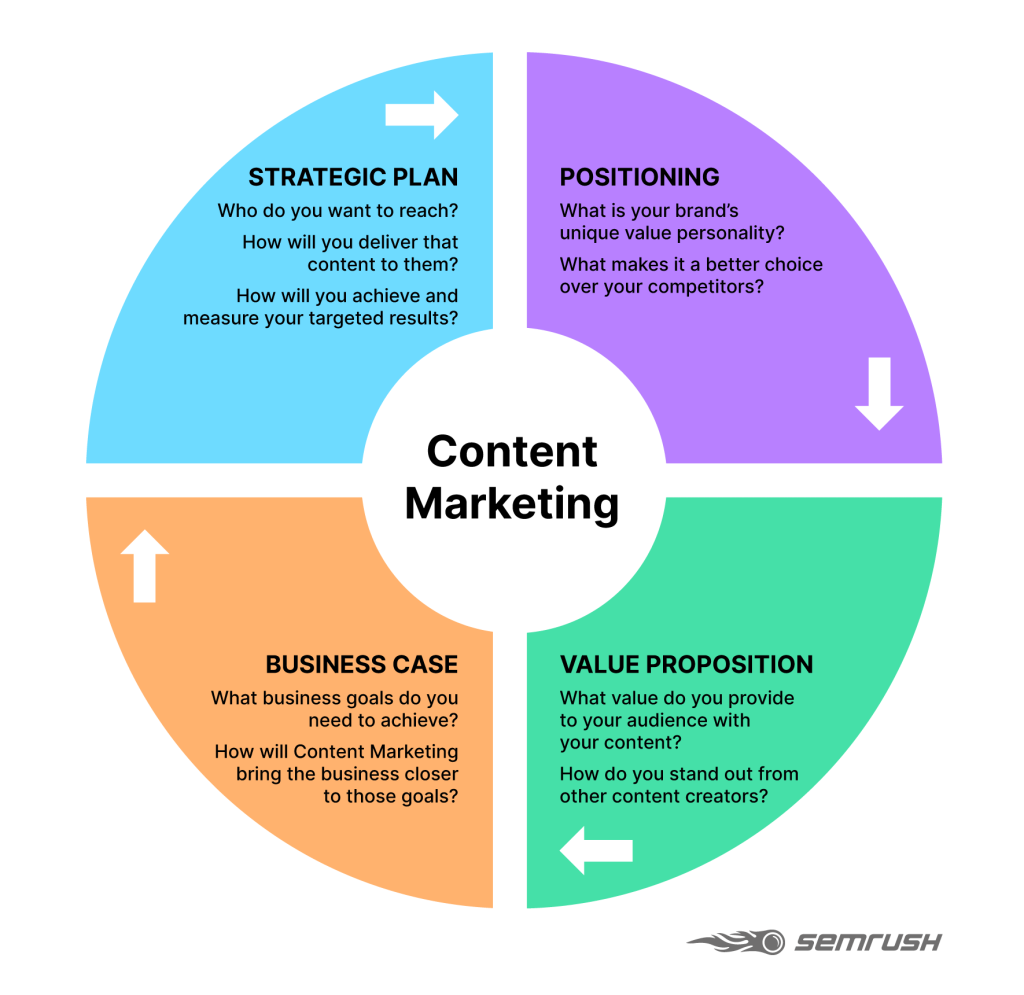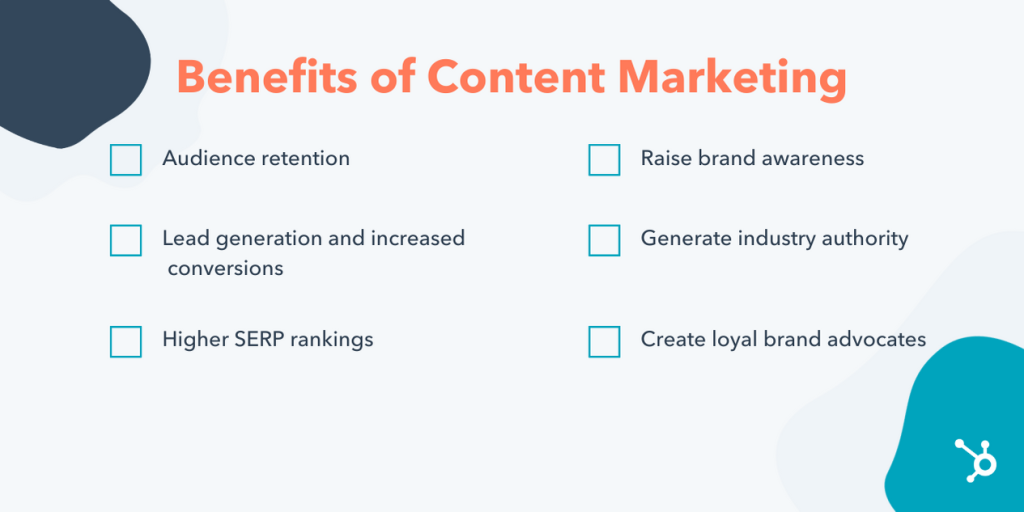Content marketing

Content marketing is a strategic approach focused on attracting, engaging, and retaining an audience by creating and sharing relevant content such as articles, videos, podcasts, and more. This strategy aims to establish expertise, promote brand awareness, and maintain a strong presence in the minds of consumers. By positioning a brand as a thought leader, content marketing builds trust and loyalty among the audience, making it particularly effective for customer retention. The key is to develop and distribute valuable content through various channels like blogs, newsletters, social media, and emails, showcasing expertise and demonstrating a commitment to customer success. Consistent use of content marketing helps nurture relationships with both potential and existing customers, increasing the likelihood that they will choose your brand when making purchasing decisions.
Importance of content marketing:-

Proven Effectiveness: Businesses with blogs experience a 67% increase in leads, and 67% of B2B marketers attribute higher engagement and lead generation to content marketing.
Competitive Advantage: Content marketing provides a competitive edge, especially in a landscape where consumers actively seek solutions to their challenges.
Lead Generation: An effective content strategy can drive traffic, leading to more leads. Educating customers through content builds trust and initiates relationships with potential customers.
Loyalty Building: Content marketing contributes to loyalty, a vital aspect of business success. Providing informative content helps build trust, encouraging repeat purchases and long-term customer relationships.
Authority Establishment: Content development is key to establishing authority and thought leadership in an industry. By consistently delivering valuable content, a brand can position itself as the go-to expert in a particular field.
How Content Marketing Works?

Content marketing is a powerful strategy that guides potential customers through the various stages of the sales cycle—awareness, consideration, and closing.
Awareness Stag: Address the top concerns of the audience, discussing pain points, challenges, and questions.Educational, how-to advice delivered through articles, blog posts, e-books, videos, and newsletters.
Examples:
- A restaurant offers a blog post on planning a graduation party menu.
- A bike touring company produces a video on “3 Ways to Choose the Right Bike Trip.”
- An architecture firm created an e-book titled “Questions to Ask Before Hiring an Architect.”
Consideration Stage: Provide a mix of helpful information and marketing, educating readers on relevant features and functions. Case studies, how-to articles, how-to videos, and checklists or worksheets.
Examples:
- A cloud-based phone system company creates a checklist on “8 Ways to Improve Your Phone Customer Service.”
- A landscaping company develops case studies on common mistakes when hiring a landscaper.
- A catering company features case studies on successful events, emphasizing benefits like accommodating food allergies and sustainable practices.
Closing Stage: Emphasize sales messaging while highlighting the expertise, knowledge, and unique benefits of your product or service.Case studies, user-generated content, buyer’s guides, product videos, and research reports.
Examples:
- A consulting firm produces a research report demonstrating the growth benefits of its strategic planning and assessment services.
- A design agency creates short videos showcasing its work across industries to highlight diverse expertise.
- An orthodontist practice encourages patient testimonials about its state-of-the-art equipment and top-notch service.
Understanding the Audience: Understanding your audience is crucial for effective digital marketing. Firstly, it allows you to target your efforts accurately by segmenting your market, and choosing the right strategies, such as social media platforms and voice, for optimal results. Secondly, audience understanding helps in crafting relevant and targeted content that resonates with specific demographics, ensuring engagement and usefulness. Lastly, it enables you to measure campaign success and make necessary adjustments, providing direction and purpose to your marketing efforts. Overall, audience understanding is the foundation for creating successful digital marketing campaigns, guiding decisions from content creation to campaign optimization.
Setting Objectives: When developing a content marketing strategy, it’s crucial to set clear objectives. These objectives may revolve around increasing brand awareness, generating leads, driving sales, or establishing thought leadership. Clear goals provide a roadmap for content creation and guide the overall direction of the marketing strategy, ensuring a focused and purposeful approach.
Content Creation: The primary goal of content creation is to attract and retain customers, with inbound marketing strategies offering valuable digital media for free. This content not only establishes thought leadership for the brand but also guides consumers in their purchasing decisions. Various types of content are strategically employed throughout the marketing funnel: SEO-optimized blogs attract new visitors at the top of the funnel, engaging mid-funnel landing pages keep readers involved, and detailed content like white papers and eBooks drive conversions. Content comes in diverse formats, including written content (blogs, articles, emails), imagery (infographics, GIFs), audio (podcasts, audiobooks), and video (animations, webinars, talking heads).
Distribution: A content distribution strategy is a systematic plan that ensures effective dissemination and promotion of content to reach a target audience. It involves identifying the audience, selecting content types, choosing distribution channels (owned, earned, and paid media), outlining promotion tactics (social media, SEO, email marketing), determining scheduling and timing, and measuring key performance indicators for analysis. The strategy aims to maximize engagement and achieve desired objectives, with continuous optimization based on gathered data for improved reach and effectiveness.
SEO Optimization: Content optimization, also known as SEO (search engine optimization), is the process of refining content to achieve higher search engine rankings and increased online visibility. Highly optimized content is prioritized by search engines, leading to better placement on search engine pages. The optimization process involves addressing various nuanced details, and considering factors such as content quality, authority, and backlinks. Search engine algorithms are complex, and effective optimization requires a comprehensive approach to enhance a website’s performance in search results.
Engagement and Interaction: To enhance audience engagement, encourage interaction through comments, shares, and likes. Actively respond to comments and questions to cultivate a sense of community and foster ongoing engagement.
Building Authority: Building authority in content marketing involves establishing your brand as a trusted and knowledgeable source in your industry. This is achieved through the consistent creation and distribution of valuable, informative, and relevant content. Authority is built over time as your audience recognizes your expertise and relies on your content for valuable insights. Key elements in building authority include providing accurate information, showcasing expertise, engaging with your audience, and maintaining consistency in delivering high-quality content. As authority grows, so does trust, enhancing your brand’s credibility and influence within the industry.
Lead Generation: In content marketing, lead generation refers to the process of attracting and capturing potential customers or leads by offering valuable and relevant content. The goal is to engage the target audience and encourage them to provide their contact information, such as email addresses, in exchange for the content offered. Lead generation content often takes the form of ebooks, white papers, webinars, or other resources that address the audience’s needs or challenges.

Analytics and Optimization: Analytics is a vital component of content marketing, offering valuable insights to shape data-driven strategies. Harnessing analytics empowers businesses to gain a deeper understanding of their audience, refine content strategies, and optimize marketing campaigns for maximum impact. This section explores how analytics plays a crucial role in enhancing the effectiveness of content marketing.
Adaptation: Adaptation in content marketing involves staying flexible and responsive to changes in audience behavior, industry trends, and technological advancements. Key elements include adjusting content to meet evolving audience needs, incorporating emerging content formats and channels, adapting to SEO and algorithm changes, utilizing user feedback and analytics insights, considering cultural sensitivities, integrating new technologies, staying compliant with regulations, and adopting a crisis-responsive communication approach. Regular assessment, flexibility, and a willingness to embrace change are essential for long-term success in the dynamic landscape of content marketing.